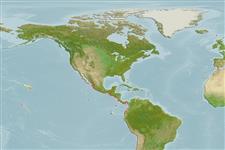>
Eupercaria/misc (Various families in series Eupercaria) >
Haemulidae (Grunts) > Haemulinae
Etymology: Anisotremus: Greek, anisos = unequal + Greek, trema, -atos = hole (Ref. 45335).
More on author: Gill.
Environment: milieu / climate zone / depth range / distribution range
Ökologie
seewasser demersal. Tropical; 24°N - 3°S
Eastern Pacific: Mexico to the northern tip of Peru.
Size / Gewicht / Alter
Maturity: Lm ? range ? - ? cm
Max length : 31.0 cm TL Männchen/unbestimmt; (Ref. 55763); common length : 20.0 cm TL Männchen/unbestimmt; (Ref. 9114)
Body compressed and deep (depth contained 1.9 to 2.3 times in standard length); mouth small and terminal with thick fleshy lips; dorsal fin with 12 spines and 15 to 17 soft rays (XII, 15-17); pectoral fins equal to or shorter than head, reaching origin of anal fin; lateral line scales 49 to 57; scale series above lateral line oblique; back golden yellow; flanks with 6 bright blue longitudinal stripes bordered with dark blue; a dark (brown or black) bar from the nape and across the eye; a similar bar from origin of dorsal fin to base of pectoral fin (Ref. 55763).
Found over hard bottoms of shallow coastal waters. Also caught with trammel nets and harpoons. Considered a valuable food-fish.
Life cycle and mating behavior
Geschlechtsreife | Fortpflanzung | Ablaichen | Eier | Fecundity | Larven
Distinct pairing during breeding (Ref. 205).
McKay, R.J. and M. Schneider, 1995. Haemulidae. Burros, corocoros, chulas, gallinazos, roncos. p. 1136-1173. In W. Fischer, F. Krupp, W. Schneider, C. Sommer, K.E. Carpenter and V. Niem (eds.) Guia FAO para Identification de Especies para lo Fines de la Pesca. Pacifico Centro-Oriental. 3 Vols. FAO, Rome. (Ref. 9114)
IUCN Rote Liste Status (Ref. 130435: Version 2024-2)
Bedrohung für Menschen
Harmless
Nutzung durch Menschen
Fischereien: weniger kommerziell
Tools
Zusatzinformationen
Download XML
Internet Quellen
Estimates based on models
Preferred temperature (Ref.
123201): 24.6 - 28.6, mean 27.5 °C (based on 32 cells).
Phylogenetic diversity index (Ref.
82804): PD
50 = 0.5039 [Uniqueness, from 0.5 = low to 2.0 = high].
Bayesian length-weight: a=0.01660 (0.00778 - 0.03542), b=3.02 (2.84 - 3.20), in cm total length, based on LWR estimates for this (Sub)family-body shape (Ref.
93245).
Trophic level (Ref.
69278): 4.2 ±0.73 se; based on food items.
Widerstandsfähigkeit (Ref.
120179): mittel, Verdopplung der Population dauert 1,4 - 4,4 Jahre. (Preliminary K or Fecundity.).
Fishing Vulnerability (Ref.
59153): Low vulnerability (21 of 100).
Nutrients (Ref.
124155): Calcium = 137 [37, 347] mg/100g; Iron = 1.19 [0.56, 2.47] mg/100g; Protein = 18.2 [16.2, 20.2] %; Omega3 = 0.176 [0.082, 0.353] g/100g; Selenium = 40.3 [18.3, 89.3] μg/100g; VitaminA = 28.7 [8.6, 98.8] μg/100g; Zinc = 0.884 [0.541, 1.357] mg/100g (wet weight);
